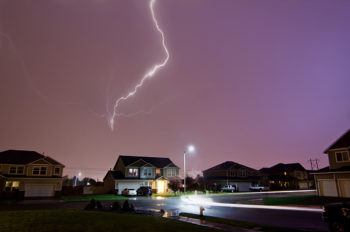Texas A&M Lightning Detection System To Aid Houston Area

Houston, you have a problem: lots of lightning.
There are more than 1,800 thunderstorms that are pounding the Earth at any given moment, meaning there are about 50 lightning strikes every second.
For Houston residents, that’s not good news. Houston is ground zero for lightning strikes in Texas. It’s the lightning capital of the state and one of the most lightning-prone areas in the world.
That’s why Texas A&M University researcher Dick Orville has established one of the most sophisticated lightning detection systems in the world – called the Lightning Detection and Ranging Network (LDAR) – in the Houston area.
Orville and his lightning team hope the system will serve as a much-needed warning system, and they also expect it to be a valuable research tool to learn more about lightning.
The system has 12 sensors placed in various locations around the Houston metro area. When there is lightning nearby, electromagnetic energy is emitted, and these sensors relay information back to the Texas A&M campus.
Valuable information, such as the intensity of the bolt and the exact location where it originated is recorded and transmitted to the National Weather Service offices in the region.
“We are working with Bill Read in the weather office at League City, which serves the Houston-Galveston area, and with Doris Hood at NASA,” Orville explains.
“One sensor can record as much as 10,000 bits of information per second about the lightning in that area,” adds Orville, who serves as head of the Department of Meteorology in Texas A&M’s College of Geosciences.
Orville says all of this information-gathering can happen within one second.
“There’s a huge amount of data we can record, but the bottom line is, this system can help save lives,” he adds.
“The system can tell Houston-area residents, such as golfers or kids playing softball, that lightning is very near and they should take precautions. It can easily give warnings from 5 to 20 minutes ahead that dangerous cloud-to-ground lightning is nearby.”
Orville says there are two kinds of lightning. One is intracloud, which can put on a brilliant display but is usually not dangerous. The other is cloud-to-ground, which can kill humans and livestock.
A bolt of lightning can be as hot as 50,000 degrees—or five times hotter than the surface of the sun. Worldwide, about 2,000 people are hit by lightning every year, and about 30 percent of those hit are killed.
In the United States, the chance of being hit is about 1 in 280,000. The results can be fatal or the injuries can cause lingering lifetime effects.
Orville’s LDAR system never takes a holiday; it runs 24 hours a day and requires four people to operate it. It is funded by the National Science Foundation.
“With this lightning detection systems, we can learn more about lightning and its behavior,” he says. “And as we learn more about it and apply this knowledge to forecasting, better information can be available to the public regarding lightning safety.”
The system can be viewed at http://www.met.tamu.edu/ciams/ldar/index.html*
* This link is no longer active and has been removed.
Media contact: Keith Randall, Texas A&M News & Information Services.





